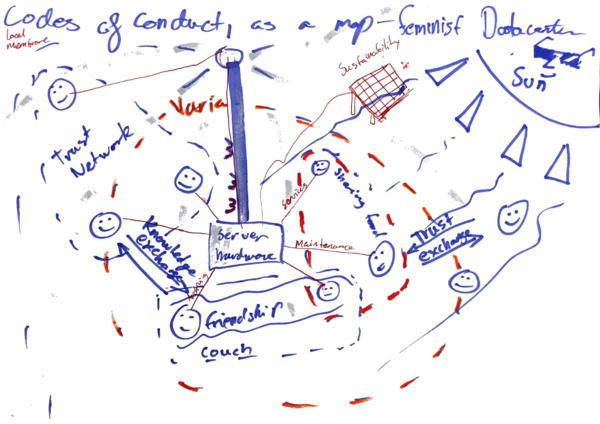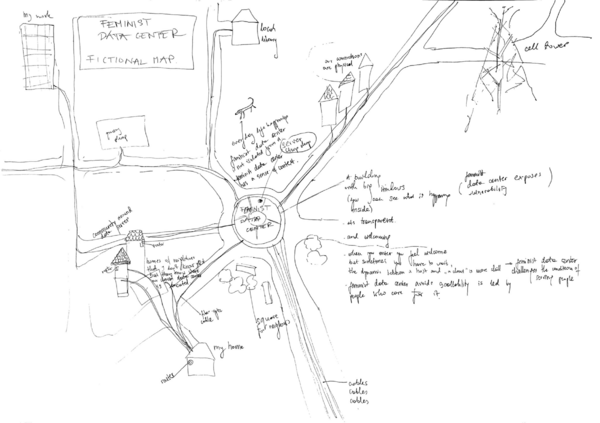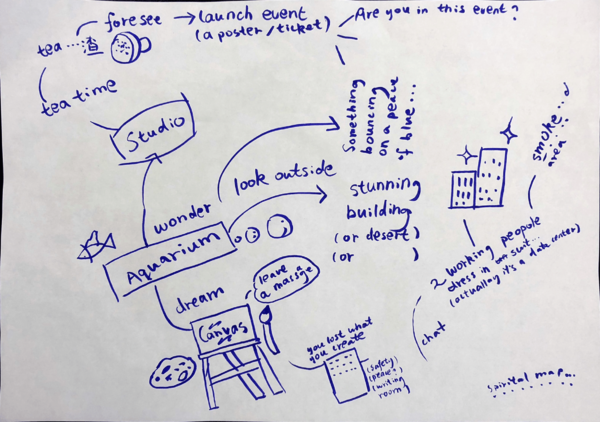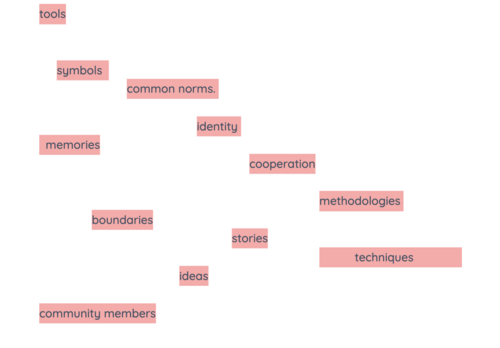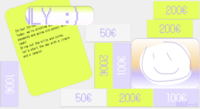Editorial Services LTD
Editorial Services LTD
From the depths of the corporate world, bringing efficiency, ease-of-use and scalability to the tips of your fingers, Editorial Services LTD come to offer you their exclusive, but also limited, editorial services. Covering at least five languages, working collaboratively and independently at the same time, we are masters in our field and aspire to lift your texts, visual graphics and webpages to unprecedented heights, and with them the price of our stock. Why do we do it? To express our passion for editing and for the money, of course.
Here you can find samples of our top notch work:
Code of Conduct
Tone: / strict / welcoming / enthusiastic / humoristic / corporate / kind | form: dialogue / script / list /
Contents
Methods can always be changed to meet different needs, therefore this code of conduct is never finished
To which activities does this Code apply?
-knowledge building and sharing
-editorial services provided
-dunch
-mapping and/or counter-mapping
- brainstorms
-collaboratively annotating
To whom does this Code apply?
These codes of conduct may apply to anyone who may engage in and/or interact with Editorial Services LTD
Date of entry into force and transitional provisions
7.02.2024 - no transitional provisions
Principles
1. Honesty vulnerability
2. Scrupulousness / leaving room for engagement and experimentation
3. Transparency ??
4. Interdependence
5. Collective responsibility
6. Collaboration
7. make it enjoyable
8. Curiosity
9. Process-oriented approach
10. Welcoming learning environment / inclusivity
11. Be respectful
12. Try to stay enthusiastic
13. Harassment is not tolerated in any form
14. adjusting the rules if needed --> methods can always be changed to meet different needs
Standards for good editorial practices
3.1 Design
-Acceptable formats: all, including images, maps, sound
3.2 Conduct
- Fabrication is part of the editorial process
3.3 Reporting results
- Part of internal communications, in the form of chit-chat
3.4 Assessment and peer review
- All decisions are collaborative, thus assessment and review happens simultaneously with getting the job done
3.5 Communication
- Clear, inclusive, respectful
3.6 Standards that are applicable to all phases of research
- Loving each other
Institutions’ duties of care
4.1 Training and supervision
- abolish power structures and hierarchies
4.2 Editorial culture
- All suggestions are valid and valuable
-ask questions
-answer questions
-let questions remain unanswered
-let answers remain unquestioned
-experiments are very welcome, even if they fail spectacularly
-If you find something difficult, you can try first and then give up with peace of mind.
4.3 Data management
- The pad manages all and we all manage the pad
4.4 Publication and dissemination
- Word of mouth, wiki, hub, print, plot
4.5 Ethical norms and procedures
-don´t be an asshole
-listen actively and attentively
-see each other
-people feel safe to express themselves and participate and stay silent
-share what you´ve got
-feel free to ask for help
Non-compliance with standards: measures and sanctions
5.1 Research misconduct, questionable research practices and minor shortcomings
- You have to make your own tea for a day
5.2 Sanctions and other measures:
- Stand alone in the corner ----nooooooooooo
- economic sanctions/boikott
5.3 Complaints and investigations
- We use a microscope for thorough investigation and complaints are protocolled and thrown in the bin, except if valid. In the latter case, we discuss over drinks and food and then throw in the bin.
Word-quilts
Autogestion
Imaginary definition
Autogestion: Traffic congestion that makes drivers and commuters secretly think about revolting against clocks and labor systems. It is often accompanied by indigestion, regardless of how much or what has been consumed, but studies have been inconclusive regarding the cause of this acute reaction. It has been suggested that it's the result of a discomforting combination of extended vehicular queueing and compulsive as well as untimely consumption of food, beverages, and useless goods and services. There have been reports of chain barfing in long traffic lines but they are unverified and the phenomenon is considered an urban myth by many sceptics. However, autogestion is taken seriously by the authorities, who try to find workarounds and give incentives to the labor force to prevent it from thinking while commuting or in general.
Actual Definition
(a) Workers' self-management. It includes workers' collectives and cooperatives and it is connected to syndicalism. Classical economic philosophers, such as Stuart Mills (liberal) and Karl Marx noted the efficiency of the model. Funnily enough, while Mills believed that companies run by autogestion would eventually displace capital-managed firms, Marx didn't.
(b) (The construction of) a self-managed economy. Closely connected to the notion of social democracy, autogestion in this context aims at building an economic system that will avoid the inequalities, irrationalities and crises created by capital- and profit-driven economic models.
Where we came across it in its mundane sense
Mentioned in Kanishka Koonewardena's essay "Space" (in Keywords for Radicals).
Corporate Property
John used to be a successful man. And that made him happy. Success, in the way he had learned it by his father and his father's father, was what he had aimed for since he was a kid. His purpose in life was to gain wealth: He bought houses, cars, huge televisions. And while all this was making him happy, one day, after a very heavy supper he had the night before, he woke up with a dreadful realization: As he owned his things, the company he worked for owned him: His time, his energy, his thoughts. Suddenly, John understood the true meaning of corporate property.
Go-Away-Green & Bye-Bye-Blue
Go away green (also knowns as no-see-um-green) and bye bye blue (also blending blue) are colors popularized by its (dis)appearance Disney Land, where they are used to obfuscate the non-attractive(attractions) infrastructures. Lamp-posts, loudspeakers, vents and fences are amongst the things that are painted these colors in order to blend in, much like military camouflage. [So that the guests don't question the illusion, but rather blissfully and oblivious go on spending their money.]
These colors also have proven useful(to governemnts and big tech maybe?) to conceal the digital infrastructure around us. We have been told that the cloud is infinite, omnipotent and immaterial. Yet enormous amounts of nature succumb at the hand(arm?) of bulldozers and excavators to facilitate data-centres, and as to add insult to injury painted to drown in the ruins(of nature).
If you want to read more about these colors you can check out this wikipedia article:
https://en.wikipedia.org/wiki/Go_Away_Green
And here are some images with colors in action:
https://www.flickr.com/photos/alexanderalzona/46462856765/
Introductory text Feminist Datacenter
Results from task from Methods class 6th of March – making introductory text for the event
During the Methods class we were discussing what a feminist data center would entail. In the extension of working with this, we were prompted to make an introductory text for a visitor at the datacenter. After som discussion the team first took some time to make drafts individually, and then at the end we recombined them to one text. This is just a draft, but entails some of the key aspects that we would like to higlight in suc an introductory text.
Recombination:
Hi! Welcome to our feminist data center. Make yourself at home! The "Feminist datacenter (maybe a cooler name is cooler)" is a place for connections and comfort and although it often remains invisible, it's part of the infrastructure that underlies our online interactions: Just like any data center, it is a physical location containing all things related to computing, such as servers, data storage drives (and the data these include), and network equipment.
Drawing attention to materiality and real socio-economic implications, we would like to welcome you in our corners. Our feminist data center transcends the division between human and tool, emphasizes social relations and reimagines the datacenter as a space where people and technologies come together in empathetic symbiosis -- a community. As a feminist data center, we redefine what it means to be a good host and challenge the relation between server and client. We are aware of our surrounding environment, while our practices are sustainable, transparent and community- instead of profit-driven: The community is served by the sharing of knowledge, and the well-being of our (wo)manpower is prioritized over efficiency. This relationship is based on trust, kindness and active work to make this space more inclusive. Situated in the heart of Charlois, it acknowledges it's context by making itself visible (and) it's intentions clear(with a temper), (and it's footprint minimal).
So please come and engage in the maintenance and building of this community, we trust you! So do you trust us?
Initial drafts:
draft 1:
Hi! Welcome to our feminist data center. Just like any data center, it is a physical location containing infrastructure related to computing, such as servers, data storage drives (and the data these include), and network equipment.
In contrast to the usual data center, our feminist data center emphasizes social relations, is aware of its surrounding environment and actively tries to support instead of destroy it. Our practices are sustainable, transparent and community- instead of profit-driven. The community around it is served by the sharing of knowledge, and the well-being of its (wo)manpower is prioritized over the data-center's efficiency.
draft 2:
The "Feminist datacenter (maybe a cooler name is cooler)" is a place for connections and comfort. It transcends the division between human and tool, and reimagines the datacenter as a space where people and technologies come together in empathetic symbiosis, a community. Situated in the heart of Charlois, it acknowledges it's context by making itself visible (and) it's intentions clear(with a temper), (and it's footprint minimal).
So please come and engage in the maintenance and building of this community, we trust you! So do you trust us?
draft 3:
Make yourself comfortable! You are in a feminist data center, this place that often remains invisible is part of the infrastructure that underlies our online interactions. Drawing attention to materiality and real socio-economic implications, we would like to welcome you in our corners. As a feminist data center, we redefine what it means to be a good host and we challenge the relation between the server and a client. This relationship is based on trust, kindness and active work to make this space more inclusive. Make yourself at home
draft 4:
Low-mid-high-tech
These thoughts are reactions to some sentiments presented in these two texts:
Ursula K. Leguin, Rant about technology:
https://www.ursulakleguin.com/a-rant-about-technology
Donna Harraway, A cyborg manifesto: https://warwick.ac.uk/fac/arts/english/currentstudents/undergraduate/modules/fictionnownarrativemediaandtheoryinthe21stcentury/manifestly_haraway_----_a_cyborg_manifesto_science_technology_and_socialist-feminism_in_the_....pdf
In the rant about technology, Ursula K. Leguin wants to challenge how main-stream discourses understands technology. She makes a point that in these discourses (related to hard/non-hard sci-fi) seem to neglect the fact that technology not only entails the high-tech, but also the non-high-tech like clothes, paper or language. A point made in the text is that "technology is how a society copes with physical reality", and this coping may entail the clothes that you wear in order to fit in at the new school, or the phone you use to call your loved ones in another country. In other words technology permeates every aspect of life in a (modern) society to some extent.
This blurring between the lines of what is our material world and what is not (in the western late capitalist techno-scientific paradigm), resonates with Donna Harraways articulation of the cyborg in the "a cyborgs manifesto". The myth of the cyborg is used to challenge boundaries between human-animal human(/animal)-machine and ultimately physical-and non physical, which is propelled by (cybernetic) technologies. Again there is this sentiment that expanding our understanding of what technology is, and can be, and how it mediates our material, social and political reality is fundamental in a feminist approach to the cultural understanding of technology.
Mapping the Feminist data center
By working with maps refering to the surroundinigs of the data center as well as abstract maps we point that an alternative feminist data- center is not isolated from our everyday actions. It Acknowledges its role within a broader context, exposes vulnerability, challenges the conditions of serving. Our reimagine data center unveil the processes, tools, and sources aiming for seamfullness.
Methods for Collaborative Editing
Misplaced concretism and concrete situations:
In the text Misplaced concretism and concrete situations: Feminism, Method, and Information Technology, by Susan Leigh Star (2016), thematics such as feminist methodology, communities of practice and boundary objects are explored. The text can be a bit challenging to follow as the author invents and builds upon different terms. Our task was to extracts some keywords and then elaborate on these as entries for the word quilt. In this process we have discussed extracts, written and re-written, in order to explore the text´s matter in our context. From this process some Methods for collaborative editing and writing has been at the core of this process, that resulted in drafts regarding the chosen keywords (methods, Boundary Objects and Communities of practice), still questions remain unanswered.
Feminism, Method, and Information Technology
K e y w o r d s - map
Selected fragments from the text: M e t h o d Susan Leigh Star, 1994 Method; "distinct from a recipe or a formula" its more of an approach rather than an exact way of achieving something.
"It is a real-time, lived, and experiential form of ordering practice." it is situated.
"Method is a way of surviving experience." [p. 148] [or experiment]
"Methods considered in this fashion may have many of the features of surviving experience, depending on the values of the community using them: they can become imperialisstic or monolithic (if one only has a hammer, the world becomes a nail, etc.); they can become a means of enforcing fundamentalism (reducing the world to that which can be perceived using the method); or they can become ways of encompassing multiplicity, complexity, and ambiguity." [p. 148]
"Feminism as a method thus creates robust findings through the articulation of multiplicity, contradiction, and partiality, while standing in a politically situated, moral collective." [p. 149]
"attributes of feminist method:
1. experiential and collective basis;
2. processual nature;
3. honoring contradiction and partialness;
4. situated historicity with great attention to detail and specificity; and
5. the simultaneous application of all of these points." [p. 149]
Patti Lather: transgressive validity - where after poststructuralism, can we find validity? ironic validity (problematizes the single voice, realist representation of nature); paralogical validity (emphasizes paradox and heterogeneity); rhizomatic validity (undermines the taken-for-granted and keeps opening up new ways of situated seeing); voluptuous validity (precisely goes too far, and joins ethics and epistemology) [p. 149 f.]
"The truth is not one thing. " Itś complex, woven carpet, with each strand a partial truth
M e t h o d (our definition)
Method is not a straightforward process as there is not only one way to go or one truth. Complexity should be taken into account when it comes to developing methods, which are very different than manuals or recipes, as it is crucial that methods can be changed along the way. For methods not to become totalitarian tools they must remain flexible and encompass multiple and often contradictory elements that may lack consistency and stability. In the heart of method lies experience, since method is "a way of surviving experience" (eg. pouring sauce over a dish baking in the oven without getting burned) but also experimentation, which will make the method viable, improve it, situate it in a specific setting or adapt it according to the tools at hand.
Selected fragment from the text - B o u n d a r y O b j e c t s
"[…] activity is always mediated through tools and material arrangements." This gives us some insight in what is considered an object.
"a community of practice is defined in large part according to the co-use of such objects" Objects have the power to connect community members, or facilitate for community.
Objects can become natural in community of practices. can be abstract or concrete common norms, standards "...we can see that the source of boundary objects comes from a combined willingness of the community of practice to accomodate marginality and multiple naturalised objects..."
boundary object is information, such as specimens, field notes, and maps, used in different ways by different communities for collaborative work through scales. "Here I mean 'Object' to include all of these things: stuff and things, tools and techniques, and ideas, stories, and memories—those objects which are treated as things by community memebers"
Our definition - A b o u n d a r y o b j e c t A boundary object can challenge common norms and standards. Different methods can apply to these objects depending on the knowledge, interests and viewpoints of the groups (or individuals) approaching them. Different communities of practice have vastly different methodologies when dealing with these boundary objects. An example of such an object could be a dead bird seen from the viewpoint of an amateur ornithologist or a biologist. In this example the ornithologists (a community of practice) might want to preserve the birds appearance to admire it, and has certain methods for this. Whilst the biologists (another community of practice) might want to dissect the bird to learn more about it. A boundary object (can be abstract or concrete) and is not just an object, but a community of practices* as well as "stuff and things, tools and techniques, and ideas, stories, and memories" that comprise many different and maybe contrasting methodologies, and it is open enough that it can include even the smallest groups and approaches. Collaboration and communication are core functions of the boundary object, since it facilitates both and opens a dialogue that can lead to a better and wider understanding of the object at hand. In this sense, a boundary object can be also seen as a piece of information serving different communities in various ways and allows them to embrace collaborative work.
Fictitious event: strike against mobile payments
Group discussion to have a virtual strike about using cash to boycott mobile payments.A promotional webpage for it.
- A community of practice is formed around such objects and methodologies, as "activity is always mediated through tools and material arrangements". Boundary objects must also be considered in terms of the motives of the people/community who choose them and their communicative role. The creation of boundary objects is always to a certain extent an expression of hegemony and as such cannot be considered politically neutral or necessarily consensual.
m. e. t. h. o. d. s.
Phenomenology of Space
"Phenomenology is a philosophical approach initially developed by Edward Husserl that centers on understanding consciousness and experience. Anthropologists interested in space and the environment have drawn on phenomenology as a way of exploring people's direct experiences of the places they inhabit. This entry outlines key approaches, critiques, and current trends. It draws attention to studies of movement and politics that are generating new possibilities in the anthropological understanding of space and the environment." [1]
[1] Vergunst, Jo (2018b): Phenomenology of space and the environment, in: The International Encyclopedia of Anthropology, S. 1–6. Doi:10.1002/9781118924396.wbiea2012.
(Un)conventional Cartographies
Unconventional cartographies are different ways of mapping the world, that push the boundaries of conventional cartography and include mapping that make sense to certain (perhaps marginalized) communities and groups, and let you experience and expand your view of the world in different ways.
Some examples of unconventional maps such the Dog World Map or the World Map of Tropical Diseases can be found all over the internet.
References
Murtaugh, M. (2021). Torn at the seams: vernacular approaches to teaching with computational tools. [online] Available at: https://vltk.vvvvvvaria.org/w/Torn_at_the_seams:_vernacular_approaches_to_teaching_with_computational_tools
Fritsch, Kelly, O'Connor, Clare, Thompson (1976), Keyywords for Radicals
Star, S.L. (1994) Misplaced Concretism and Concrete Situations: Feminism, Method, and Information Technology. In: Bowker, G. et al. (eds) Boundary objects and beyond: working with Leigh Star. Cambridge, Massachusetts: The MIT Press (Infrastructures series). https://hub.xpub.nl/bootleglibrary/book/863
Smith, David Woodruff (2003): Phenomenology. In: The Stanford Encyclopedia of Philosophy. Online. URL: https://plato.stanford.edu/cgi-bin/encyclopedia/archinfo.cgi?entry=phenomenology
Vergunst, Jo (2018b): Phenomenology of space and the environment, in: The International Encyclopedia of Anthropology, S. 1–6. Doi:10.1002/9781118924396.wbiea2012.
https://pad.xpub.nl/p/phenomenology-of-space
https://en.wikipedia.org/wiki/Esperanto



